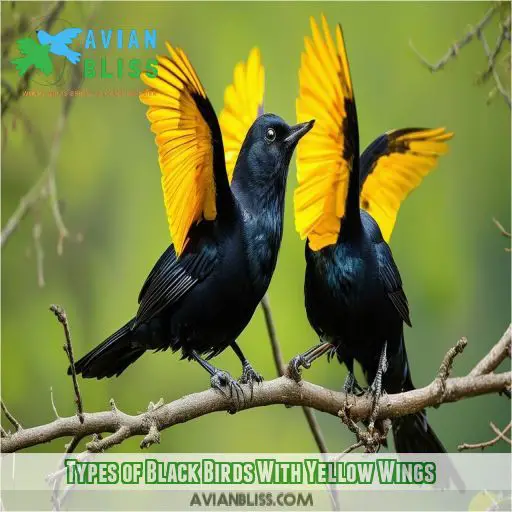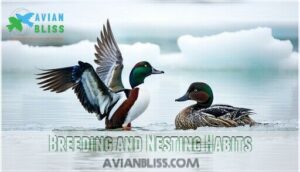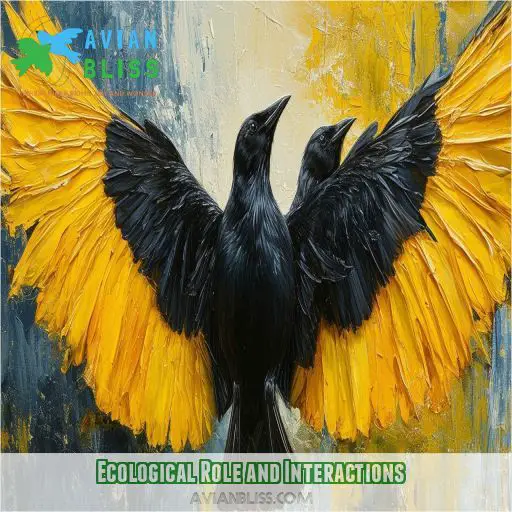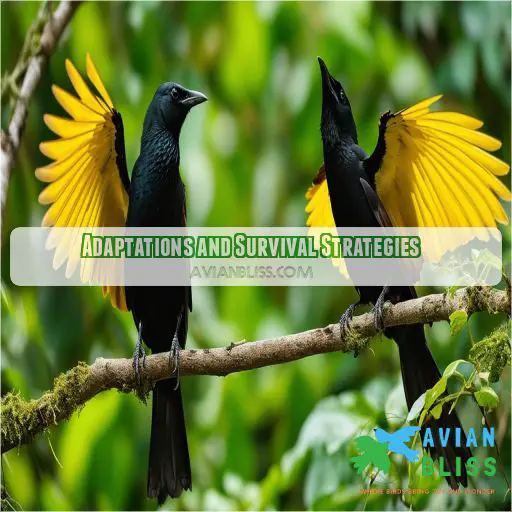This site is supported by our readers. We may earn a commission, at no cost to you, if you purchase through links.
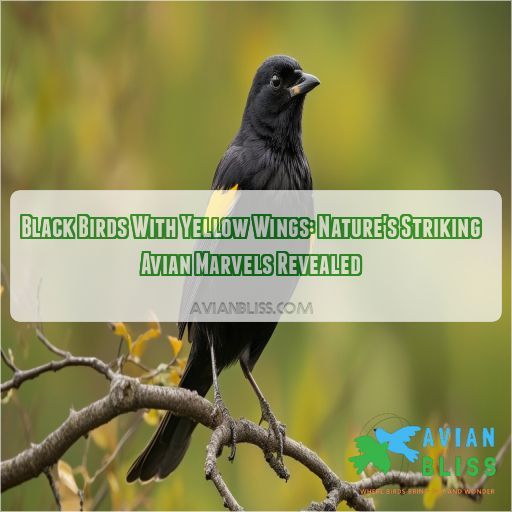 Imagine a swipe of yellow against the sky, and your head turns.
Imagine a swipe of yellow against the sky, and your head turns.
The dramatic color combination of black birds with yellow wings makes them stand out in their environments.
In this guide, you will learn about identification tips, from plume patterns to unique songs.
With information distilled down for accessible empowering into your bird-watching skills, soon you will be proficient at the identification and appreciation of such beautiful avian species.
Open up the secrets of these intriguing birds!
Table Of Contents
- Key Takeaways
- Types of Black Birds With Yellow Wings
- Physical Characteristics and Identification
- Habitat and Distribution
- Diet and Feeding Behavior
- Breeding and Nesting Habits
- Vocalizations and Communication
- Ecological Role and Interactions
- Conservation Status and Threats
- Adaptations and Survival Strategies
- Cultural Significance and Human Interactions
- Frequently Asked Questions (FAQs)
- Are yellow-winged blackbirds rare?
- How to attract Red-winged Blackbirds?
- What does it mean if you see a red-winged blackbird?
- What does the Yellow-winged Blackbird mean spiritually?
- What is the role of wing characteristics in mating?
- How do these birds migrate seasonally?
- Do these birds show any signs of tool use?
- How do young birds learn to forage?
- What are the primary predators of these birds?
- Conclusion
Key Takeaways
- Yellow-winged wonders: Discover the captivating beauty of black birds adorned with vibrant yellow wings!
- Diverse habitats, diverse species: From the South American pampas to North American fields, these birds inhabit a wide range of ecosystems, each with its own unique species.
- Ecological superstars: They’re not just pretty faces! These birds play crucial roles in seed dispersal and pest control, keeping our ecosystems balanced.
- Cultural connections: Across cultures, black birds with yellow wings carry symbolic meanings, from transformation to good fortune.
Types of Black Birds With Yellow Wings
You’ll encounter three main types of black birds with yellow wings: the Yellow-winged Blackbird, Yellow-shouldered Blackbird, and Red-winged Blackbird. Each species has distinct yellow markings on their wings, but they differ in size, habitat preferences, and geographic distribution across the Americas.
Yellow-winged Blackbird
You will find the Yellow-winged Blackbird soaring in the South American skies, with their aesthetic plumage testifying to nature’s artistry.
Their bright yellow wings aren’t only for beauty; they’re integral to mate attraction and territorial displays by this blackbird.
The variation among subspecies and genetic diversity has caused these birds to adapt to various habitats, showing remarkable beak morphology and flight patterns.
Yellow-shouldered Blackbird
As you explore Puerto Rico’s avian wonders, you’ll encounter the yellow-shouldered blackbird, a close cousin of its yellow-winged relative. This endangered member of the Icteridae family boasts striking plumage and unique behaviors. Here are three key features:
- Glossy black feathers adorned with vibrant yellow shoulder patches
- Sexual dimorphism evident in size and coloration
- Omnivorous diet adapting to various food sources
Red-winged Blackbird
You’ll spot red-winged blackbirds easily by their distinctive markings. These aggressive songbirds display striking polygamy behaviors and engage in fierce territorial disputes. Here’s a quick guide to their key features:
| Feature | Male | Female |
|---|---|---|
| Plumage | Black | Brown streaked |
| Epaulets | Red with yellow | None |
| Size | Larger | Smaller |
| Song | Conk-la-ree! | Chatter |
Watch for their seasonal molting and be aware of habitat fragmentation affecting these Agelasticus members.
Physical Characteristics and Identification
When identifying black birds with yellow wings, you’ll need to pay attention to their distinctive plumage patterns, overall size and shape, and any Sexual dimorphism present. These physical characteristics can help you distinguish between different species, as males often sport brighter yellow patches while females may have more subdued coloration.
Plumage Patterns
Now that we’ve covered the different types of black birds with yellow wings, it’s time to view some of their beautiful plumage designs. In this regard, you’ll see a wide variety of species in terms of the plumage display. Here are the three key features to look for:
- Bright yellow wing spots or shoulder patches
- Shiny black body with yellow accents of contrasting color
- Slight variations in shades of yellow among species
Size and Shape
You’ll notice these black birds with yellow wings have distinctive sizes and shapes. Their wing length varies, but most sport long conical bills perfect for seed-cracking. Body proportions differ among species, with some like Brewer’s blackbird appearing sleeker than others. Watch for their unique postures and tail sizes, key identifiers in the field.
Sexual Dimorphism
You’ll notice striking differences between male and female black birds with yellow wings. Males typically sport vibrant black plumage with bold yellow patches, while females often have duller, brownish feathers. This sexual dimorphism extends to size, with males generally being larger. Some species, like the black-and-gold cotinga, show extreme color variations between sexes.
Habitat and Distribution
Black birds with yellow wings inhabit a diverse range of ecosystems, from grasslands and wetlands to agricultural areas and forests across the Americas. You’ll find species like the yellow-winged blackbird in South America’s pampas, while the red-winged blackbird occupies marshes and fields throughout North America, with some populations undertaking seasonal migrations.
Preferred Ecosystems
You’ll find these striking birds in diverse ecosystems. From wetlands to grasslands, they’ve adapted to various habitats. Genus Oreopsar and Xanthocephalus showcase remarkable niche partitioning. Forbes’s and Brewer’s blackbirds thrive in different areas, reducing intraspecific competition. The yellow-hooded blackbird’s habitat preferences highlight the species’ dispersal patterns across ecosystem types.
Geographic Range
You’ll find these striking black birds with yellow wings across diverse regions. The tawny-shouldered blackbird calls the Caribbean home, while the tricolored blackbird thrives in western North America. Pale-eyed and unicolored blackbirds inhabit South America, and the scrub blackbird’s range extends from Panama to Peru. Their distributions often overlap, creating vibrant birdwatching opportunities in various habitats.
Migration Patterns
You’ll find fascinating migration patterns among black birds with yellow wings. The yellow-rumped cacique, for instance, travels impressive distances seasonally. Watch for epaulet orioles at stopover sites, where they replenish energy reserves. Black siskins use remarkable orientation cues during their journeys. Variable orioles and golden-tufted mountain grackles, however, tend to be more sedentary, mastering their local habitats year-round.
Diet and Feeding Behavior
Black birds with yellow wings have diverse diets that include seeds, insects, fruits, and small vertebrates, varying by species and season. You’ll often see them foraging on the ground or in low vegetation, using their strong bills to probe for food and employing various techniques to access different food sources.
Common Food Sources
You’ll find these black birds with yellow wings are quite adaptable eaters. Their food preferences range from seeds and grains to insects and small vertebrates. Seasonal feeding patterns influence their diet, with new world blackbirds like the yellow-headed blackbird and Brewer’s blackbird adjusting their nutritional intake. They’re not picky, often competing for resources with other species.
Foraging Techniques
These birds are going to utilize a whole array of foraging behaviors. Their uniquely shaped beaks are tailored to their favorite seeds. Observe the flock—notice how:
- Ground-feeding techniques
- Tree-foraging methods
- Wetland probing behaviors
Habitat selection is essential in their feeding success. Foraging adaptations differ for all species, from the rusty blackbird to the scarlet-headed blackbird.
Seasonal Variations in Diet
You’ll notice these birds’ diets shift with the seasons. In summer, they’ll feast on insects, while winter sees them turning to seeds and grains. The forbes blackbird, belonging to genus Curaeus, adapts its foraging techniques to match available food sources. Geographical variations also play a role, with species like Chrysomus and Anumara showing unique dietary adaptations.
Breeding and Nesting Habits
You’ll find that black birds with yellow wings engage in fascinating breeding rituals, with males often establishing territories and performing elaborate displays to attract mates. Once paired, females typically take charge of nest construction, carefully weaving grasses and other plant materials into a sturdy cup-shaped structure where they’ll lay and incubate their eggs.
Mating Rituals
Some birds, like the Resplendent Quetzal, also exhibit intricate mating rituals as part of their unique behaviors, including vibrant displays of emerald feathers avain wonders. You’ll witness fascinating mating rituals among black birds with yellow wings. Males perform elaborate courtship displays, vying for female attention. Species like the melodious blackbird and chopi blackbird showcase their vibrant plumage and sing complex songs. Some, like the Jamaican blackbird, engage in lek mating systems, where males gather to compete for mates. Polygamy is common in many species.
Nest Construction
Such birds develop complicated nests in different parts of their habitat. Grass, twigs, and mud are some materials they pluck to interweave.
Some, like the Brewer’s blackbird, prefer open fields, while others require deep vegetation.
The defense of their nests is a critical aspect of their life cycle. They have males that usually defend the nest from intruders.
Sharing nests between two females of certain species of blackbirds is quite a common phenomenon.
Egg Laying and Incubation
You’ll find black birds with yellow wings fascinating during egg laying and incubation. They typically lay 2-5 eggs per clutch, with the female taking charge of egg care. The incubation period varies by species, but nestlings usually hatch within 10-14 days. Egg weight and brood size depend on factors like habitat quality and food availability.
- Montane widowbirds build intricate nests for their precious eggs
- Hispaniolan orioles fiercely defend their nests from predators
- Golden-crested mynas have unique egg coloration patterns
- Forbes’s blackbirds share incubation duties between partners
- Brewer’s blackbirds adjust clutch size based on food abundance
Vocalizations and Communication
You’ll find that black birds with yellow wings use a variety of vocalizations and displays to communicate. Their songs and calls serve multiple purposes, from attracting mates and defending territories to coordinating movements within flocks.
Songs and Calls
You’ll be amazed by the diverse vocalizations of black birds with yellow wings. From the metallic "konk-la-ree" of red-winged blackbirds to the whistling songs of Puerto Rican orioles, these birds exhibit fascinating geographic variations and pitch differences. Their calls evolve through vocal learning, with some species like the Brewer’s blackbird adapting their flocking communication to urban environments.
Territorial Displays
Beyond their melodious songs, you’ll witness fascinating territorial displays from these black birds with yellow wings. Males fiercely defend their turf through vocal duets and impressive aerial maneuvers. Watch for mountain caciques and Forbes’s blackbirds performing intricate mating rituals. These displays often coincide with seasonal migrations and habitat preferences, influencing the formation of feeding flocks in grasslands.
Flock Communication
The intricacies of the flock communication by this black bird with yellow wings will simply awe you. Then, being social, many vocalizations are applied to hold the group together in wetlands and marshes. Listen closely, and you might hear:
- Alarm calls that alert individuals to the presence of predators
- Contact calls keeping the flock together during flight
- Hierarchical Chirps—Used to establish the social ranking in a group.
Their complex communication patterns ensure survival in challenging environments.
Ecological Role and Interactions
Blackbirds with yellow wings perform critical ecological functions related to seed dispersal and pest management, thus developing plant communities and regulating the populations of insects. Within food webs, these species become key players by acting as predators and prey, influencing dynamics in a wide range of ecosystems they inhabit.
Seed Dispersal
These black birds with yellow wings thus become a crucial part of seed dispersal. In search of food, they accidentally disperse seeds into different habitats.
This will have a bearing on the dynamics of seed banks and the germination rate. Even though some seeds are consumed, most remain viable, making the process efficient for seed dispersal.
How amazing it is that these birds’ daily activities can change an ecosystem.
Pest Control
You’ll find these winged wonders aren’t just eye-catching; they’re nature’s pest control experts. With their keen eye for pest identification, they swoop in to tackle insect populations that might otherwise run rampant. Their adaptability to chemical resistance in pests makes them invaluable allies in biological control efforts, surpassing many human-made solutions in effectiveness.
Predator-Prey Relationships
You will find out that blackbirds aren’t just regulatory agents for pests but key players in nature’s bigger game. Their adaptations help them evade predators while they aggressively protect their territories from other birds.
Observe how they scatter seeds around, landscaping the areas. Of course, all of this isn’t flowery because threats lurk over their nests.
The patterns of migration shape these predator-prey balances.
Conservation Status and Threats
You’ll find that many black birds with yellow wings face conservation challenges due to habitat loss and climate change impacts. Their population trends vary, with some species experiencing significant declines while others remain stable, highlighting the need for targeted conservation efforts to protect these stunning avian species.
Population Trends
Trends in the populations of black and yellow-winged birds differ considerably.
There are seasonal solid migrations and breeding habits playing a significant role here.
The overall conservation measures are pretty decent, with some species having been noted for a rather sharp decline due to human interactions and habitat changes.
Ecological research will ensure maintained species diversity by following these shifts and help strategize their protection for these avian wonders.
Habitat Loss
Habitat fragmentation and urbanization spell a significant threat to the populations of black birds with yellow wings. The problems are emphasized by pesticide use and introduced species that reduce the amount of native food and space for nesting. Preserving natural habitats and easing these human-imposed pressures ensure that such fine-colored birds survive.
Climate Change Impacts
Climate change impacts these black birds with yellow wings altering their habitats and food sources. Warmer temperatures can shift breeding seasons and migration patterns, disrupting reproductive success. Additionally, extreme weather events like droughts and floods can reduce food availability, making survival tougher. Adapting to rapid changes is critical for their continued existence.
Adaptations and Survival Strategies
You’ll find black birds with yellow wings use camouflage to blend into their environments, aiding in predator avoidance. Their flocking behavior also enhances survival by creating confusion among predators and bolstering mutual protection.
Camouflage Techniques
Your black feathers act as natural camouflage, blending seamlessly into the shadows. Your pointed beak is perfectly adapted for cracking seeds, while your vocal mimicry helps you deceive predators. Geographic variations in your appearance and song further enhance your survival strategies.
Flocking Behavior
Flocking behavior in black birds with yellow wings offers various survival strategies. They form large flocks, enhancing foraging efficiency and predator detection through coordinated efforts. You’ll often notice:
- Flock dynamics: Social hierarchies emerge, determining pecking order.
- Seasonal migrations: They travel together for resources.
- Habitat preferences: Choose areas with ample food supply.
Predator Avoidance
The black bird with yellow wings has different defense strategies to ensure it doesn’t end up part of a predator’s meal. Flocking behavior enhances vigilance and deters attack by lone predators. Anti-predator adaptations, such as cryptic plumage, come in handy. The group dynamics are just effective enough to defend the nests.
| Adaptation | Purpose |
|---|---|
| Flocking Behavior | Increased Vigilance |
| Cryptic Plumage | Camouflage |
| Alarm Calls | Alert others |
| Mobbing | Deter predators |
| Defense of the Nest | Protection of the Offspring |
Cultural Significance and Human Interactions
Globally, the black bird with yellow wings has drawn the interest of cultures worldwide and, in most cases, symbolizes transformation and mystery. They’ve a powerful interaction with agriculture in increasing pest control, and their outstanding coloration makes them a favorite among bird watchers and ecotourists.
Symbolism in Various Cultures
Black birds with yellow wings hold various cultural significances across folklore and mythology. They symbolize different beliefs:
- Transformation: Many cultures see them as messengers of change.
- Spiritual Guides: Often seen as guiding spirits in indigenous mythology.
- Good Fortune: Linked to prosperity and luck.
- Mystery: Represent the unknown.
- Protection: Believed to ward off evil.
Impact on Agriculture
Blackbirds with yellow wings could offer a great deal of contribution to agriculture.
The foraging behavior of these birds could be very harmful to crops, particularly grains and fruits. However, they also bring along economic importance in terms of reducing the population of insects.
Knowledge of behavior and habitat good farm management could help reduce harmful effects and gain from their beneficial properties of controlling pests.
Birdwatching and Ecotourism
Blackbirds with yellow wings present beautiful opportunities for tourism. Such trips to these locations increase the economic value of this venture and, at the same time, broadcast messages related to conservation. Their habitats provide valuable cultural heritages and also maintain ecological balance. Seeing these birds in their natural environment offers a lifetime experience and significantly increases their economic value.
Frequently Asked Questions (FAQs)
Are yellow-winged blackbirds rare?
Yellow-winged blackbirds vary in rarity. Some species, like the yellow-shouldered blackbird of Puerto Rico, are endangered, while others are more abundant. Their conservation status largely depends on habitat and regional threats they face.
How to attract Red-winged Blackbirds?
More than 80% of Red-winged Blackbirds nest in cattail marshes. To attract them, offer seeds, cracked corn, and millet in ground feeders. Plant tall grasses and cattails to create favorable nesting sites and water sources.
What does it mean if you see a red-winged blackbird?
Seeing a Red-winged Blackbird often symbolizes change and renewal. Their presence might suggest you’re entering a phase of personal growth and adaptability, reflecting the bird’s vibrant red and yellow epaulets and dynamic behaviors.
What does the Yellow-winged Blackbird mean spiritually?
Keep your eyes peeled, as spotting a Yellow-winged Blackbird signifies a time of transformation and new beginnings. Their striking appearance embodies resilience and adaptability, encouraging you to embrace change and move forward with confidence.
What is the role of wing characteristics in mating?
The characteristics of the wing during this phase of mating are essential in their way of expressing fitness and health. Colorful, clear markings can attract potential mates by signaling genetic superiority and the ability to thrive within that environment. In that respect, it helps raise the rate of successful mating.
How do these birds migrate seasonally?
Approximately 40% of these birds migrate seasonally to exploit new food resources and favorable climates. You’ll find them journeying from breeding sites in temperate regions to wintering grounds in tropical areas, ensuring their survival and reproductive success.
Do these birds show any signs of tool use?
No, these birds don’t show signs of tool use. Their feeding behavior is largely based on ground foraging for seeds, insects, and small vertebrates. They use their conical bills for cracking seeds and accessing food efficiently.
How do young birds learn to forage?
Young birds learn to forage by observing and mimicking their parents and flock members, developing their skills through trial and error. This essential learning process helps them identify edible food sources and effective feeding techniques.
What are the primary predators of these birds?
These birds’ main predators are raptors like hawks and eagles, snakes, mammals such as raccoons, foxes, and domestic cats. These birds must face dangers from predators in the sky and on the ground. Vigilance and camouflage become very important for survival.
Conclusion
What is the fascination of black birds with yellow wings, you ask? By now, you’re equipped to identify these striking species, understand their habitats, and recognize their vital ecological roles.
You have learned about the vibrant patterns of their feathers and unique songs that give a little insight into life. Enhancing these capabilities as a bird-watcher isn’t only more appreciated but also the possibility of playing a small part in their conservation.
Happy Bird Watching; may such encounters be plenty!

